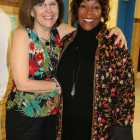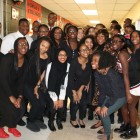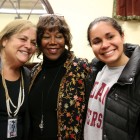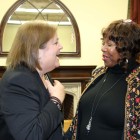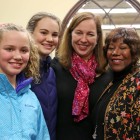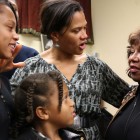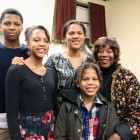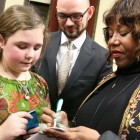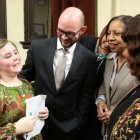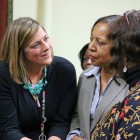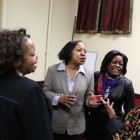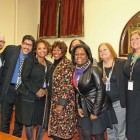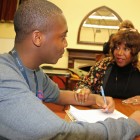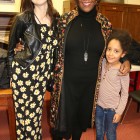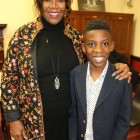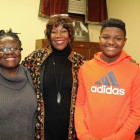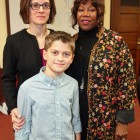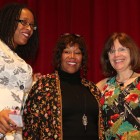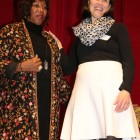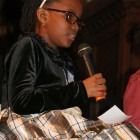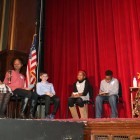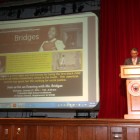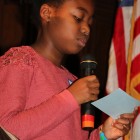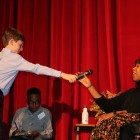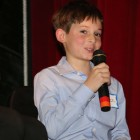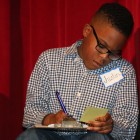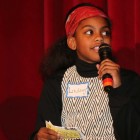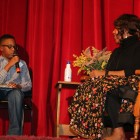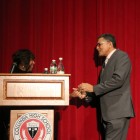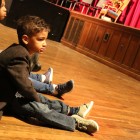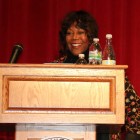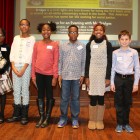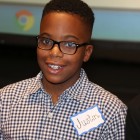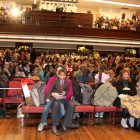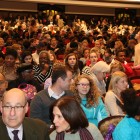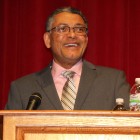South Orange-Maplewood Superintendent of Schools Dr. John Ramos introduced activist and historical icon Ruby Bridges to an overflowing auditorium at Columbia High School on Thursday night. Bridges, who is known for being the first black student to attend an all white elementary school in New Orleans, Louisiana, spoke in front of a packed house — there was not a seat to be had as people lined up in the aisles and hundreds were turned away at the door.
The evening began with a video showing footage of Bridges as a child being led into the William Frantz Elementary School by four U.S. marshals. She began her story, telling the crowd that she had attended kindergarten in an all black school in New Orleans. She started first grade there as well, but when the laws began to be enforced in November 1960, the NAACP went door to door to the homes of the black families in the neighborhood and gave 140 students a placement test. Only six passed; she was one of them.
Bridges laughed as she told the crowd that she thought, “I am so smart. I am going from first grade straight to college!” So on her “second first day of school,” the entire community came to her home to help her get ready for the big day. Her mother seemed surprised when four U.S. marshals showed up at their door to take her to school since it was located so close to their home, but they were given orders by the President of the United States to be there to escort her. Bridges rode with her mother to school and the entire neighborhood followed the car. She said those neighbors walked behind that car every day, “because it takes a village to raise a child” and her community was that village.
When she saw the mobs of people outside of the school throwing things at her and at the car, she just assumed it was a parade like Mardi Gras. Bridges said that she hadn’t experienced racism before, so she didn’t think the crowds were there because they hated her and the idea of a black child in their schools. She wasn’t afraid. She told the audience at Columbia High School that she had the innocence of a child who had not been tainted in any way. “I was six,” she said, “I knew nothing of what would happen that day. My parents couldn’t prepare me. No one could have.”
Bridges said that her parents weren’t given the opportunity of a good education and although her mother was very excited, her father was skeptical. He had fought in the Korean War. He said that on the front line, white and black men fought together, yet when they went back to their barracks, they were separated by race. They could fight together and die for their country side by side, yet they couldn’t eat or socialize together otherwise. He didn’t want Ruby subjected to this, but her mother made the final decision and she went.
That first day, as she sat in the office of the principal (who did not want her there), Bridges saw hundreds of people rushing by the windows — adults and children. Over 500 students attended the school. She just assumed, “college is a busy place.” She didn’t realize that it was parents pulling their children out of the school because they did not want their children in a school with a black child. After spending that entire day in the principal’s office, the U.S. marshals led her back home. Bridges said that her mother didn’t realize the impact of what had happened until she saw it on the news that evening.
The next day, Bridges told the crowd, she met her teacher — a woman named Mrs. Henry, who came from Boston. Many of the teachers at the school had quit because they refused to teach a child who was not white. Bridges’ first thought was, “Wow, I have never seen a white teacher before.” She was alone in that classroom. Mrs. Henry taught her anyway. Bridges said she doesn’t remember much about what was going on outside of the school. She just kept wondering where all of the other children were.
Bridges told a story about smelling food coming from the cafeteria and wanting to go there. She wasn’t allowed to eat that food because of the threats of people poisoning her, so she had to bring lunch from home each day. She ate alone in the classroom, while the marshals stood outside of the room. She got so tired of peanut butter and jelly sandwiches and wanted to dine in the cafeteria so badly, she began hiding the sandwiches in the classroom closet – which became a problem when mice started to infest the room. Her teacher decided to take her to the cafeteria and ate with her every day.
Bridges explained that she still could not understand why there were no children at the school. She insisted that she could hear children laughing and finally, her teacher showed her a secret door, which led to a hallway that had a classroom with a few white children in it. Mrs. Henry told the principal that they would learn together or she would turn him in for breaking the law. That is how she finally got to be in class with other children. One of the boys told her, “My mama told me I can’t play with you.” Bridges said, “That was when I realized this was all about me and I understood.”
She also realized that racism is something that is learned.
Bridges said she realized something about Mrs. Henry: although Mrs. Henry looked like those people on the outside of the school, she didn’t act like them. Bridges said she is still in contact with Mrs. Henry; they talk weekly and see each other twice a year.
“It is so hard for our children to imagine what it was like back then, but it is a conversation we must have with them,” Bridges told the crowd. “I see hope that most of you don’t have the opportunity to see. We are going to make it and it is because of your children. You are already showing that you are doing a good job raising your kids….
None of our babies come into the world knowing anything about the baby laying next to them. It isn’t because they can’t speak. They start with a fresh, clean heart. It is grownups who pass along racism. You are robbing your child of that clean heart. Racism is a grown up disease and it is time we stop using kids to spread it. We have come a long way but we all have to contribute.”
Bridges continued: “Good and evil come in all shades and colors. Evil looks like me and you. We are all being separated by good and evil.” She shared a very personal story telling about how one of her sons was murdered “by a person that looked like me.” Bridges kept stressing that the difference is not race, but good versus evil.
Five fifth grade students, one from each elementary school were given the opportunity at the end of Ms. Bridges’ presentation to ask her a question:
- Justin Henry ofTuscan School asked, “Once you settled into your new school, were the kids nice to you? Who was your first friend?”
- Lindsey Minor of South Mountain School asked, “Tell us please, how do we respond to the little voice inside each of us that says we girls don’t have the courage to be leaders?”
- Nicole Phillip of Seth Boyden School: “I see on the news many African Americans struggling. As they struggle, how would you inspire African Americans to follow their dreams?”
- Jordan Klein of Jefferson School: “At what point in your life did you realize what you did was important to the civil rights movement and why?”
- Zahra Jones of Clinton School: “Did you ever feel intimidated to go to the William Frantz School and when did you realize what a big deal it was for you that day?”
Ms. Bridges ended the evening with the following message: “Evil is our enemy. It is time to come together to protect our children. It is not the color of our skin. Racism is an excuse. Racism is fueled by hatred and evil. We owe it to our children to do better. Let our children keep their innocence. I refuse to believe there is more evil than good. We can definitely make a dent and make it better for our kids. I urge you to speak to every child and let them know that racism has no place in the hearts of our children. We need hope. I am here to say there is hope. It is in your kids. If you are about good, then I want you on my team!”
After the presentation Village Green and Jordan Miller of the Columbia Cable Network were given the opportunity to ask Bridges some questions. This reporter had come prepared with a list of questions from K-2 students at Tuscan School, but most of them had already been answered throughout her presentation, so I asked the only one that hadn’t already been answered: “Why did you decide to travel around the world and talk about your life?” Bridges said she was convinced by Scholastic, her publishers, and once she saw how moved people were by her story, and how it inspired them and made a difference, she knew she had to keep doing it. Her largest crowd was a group of 8,000 teachers, but she finds crowds the one at Columbia High School different because she was speaking to families and that is who she is trying to reach.
Jordan Miller asked Bridges how she felt about “things going on with police officers and how race is involved.” Her answer was simple and it was concise: “It is wrong for anyone to stereotype. Race should never come into play. Once again it brings us back to good vs evil. This is not just black vs white.”
He asked, “How can we as high school students do better and spread goodness.” Her reply, “You know this don’t you? You are here. You know right from wrong. Just keep doing it. Do the right things. Spread joy.”
Students from Columbia’s MAC (Minority Achievement Community) Scholar program served as ushers for the evening and had the chance to meet Bridges. The MAC scholars are part of the Minority Student Achievement Network (MSAN), a national network whose school district members are committed to closing the achievement gaps. Students from CHS attend the annual conference, meet weekly with mentors, organize study groups, and have begun a “Mini Mac” mentoring program at our district elementary schools.
The event was arranged by Toshie Davis, Marshall PTA President and presented by Karen Wieland and The Parenting Center, along with the elementary school PTA’s.

